0 Introduction
The concept of the Caspian Energy Ring (CER) was proposed in [1,2].In [1],the CER was interpreted broadly as the interconnection of various energy infrastructures in the Caspian region.The study in [2]considers the CER as an interconnection of the national power systems (NPSs)of the Caspian Sea basin countries,including Russia,Kazakhstan,Turkmenistan,Iran,and Azerbaijan (Fig.1).In addition,several studies have focused on the entire CER [3,4].In particular,most studies considered the existing or developing power interconnections of Caucasus countries,Central Asian countries,and Central and South Asian countries [5-7].Some of these interconnections are fragments of the CER.This study considers the entire CER,taking into account external electric ties with neighboring power system interconnections.

Fig.1 Caspian Energy Ring (CER) [1]
The CER project has the following features: First,CER countries have significant potential as fuel and energy resources,particularly natural gas.Natural gas with low carbon emissions is actively used by the CER countries for power generation.Thus,the power generation sectors of Caspian countries are more environmentally friendly.Second,CER countries are involved in existing power system interconnections.Thus,the power systems of Russia,Kazakhstan,Turkmenistan,and Azerbaijan,covered by the CER,also operate as parts of the interstate power grids(ISPGs) created based on the former unified power system(UPS) of the USSR,namely,the interconnected/UPS (IPS/UPS),which includes the power interconnection of Central Asia.In addition,CER countries have close interstate electric ties (ISETs) with countries in other regions.Thus,Central Asian countries have ISETs with South Asian countries (particularly Afghanistan) and the Middle East(i.e.,Iran).The Caucasus also have ISETs in the Middle East (Iran).The third feature is that the CER itself can become a link between the already existing European power interconnection and the emerging Asian Supergrid,thereby contributing to the formation of the Eurasian Supergrid [8]as an element of the global power interconnection [3,9,10].
Projects similar to the CER at different stages of implementation have been proposed in different regions of the world.Thus,the Baltic Energy Ring already exists,interconnecting the NPSs of the Scandinavian peninsula and part of mainland Europe [11].The Mediterranean Energy Ring interconnects the power systems of Southern Europe,North Africa,and Western Asia [12].The Black Sea Ring project,which also claims to be intercontinental as it interconnects the countries of Europe and Minor Asia,has not yet reached the implementation stage [13].
In recent years,multilateral and bilateral contacts have intensified to strengthen existing and build new ISETs between the Caspian countries in the direction of Armenia,Russia,Iran,Georgia (2016),Iran,Azerbaijan,Russia(2019),and Turkmenistan and Iran (2021) [14-16].The signed agreements and consents reached can be considered as the first practical activities contributing to implementation of the CER.
The first quantitative study of the CER is presented in[4].The study preliminarily determined the benefits and economic viability of the CER.In this study,countries were grouped by region,and each region was represented by one separate node in the CER ISPG diagram (Russia,being the largest actor of the CER,is represented by two nodes).Thus,the CER power system interconnection was considered in this study as quite general,and requires further representation and study,which was the aim of the present study.
The study described herein considers a more detailed CER ISPG diagram,where each country is represented by a separate node (Russia is represented by five nodes).Accordingly,because of the large number of nodes,in the new study,the power grid infrastructure (including electric ties that shape the CER) is presented in much more detail than in a previous study.Thus,it is possible to evaluate the specific technical and economic parameters (i.e.,transfer capabilities,power exchanges,and investments) of the CER.The economic benefits of forming the CER are also estimated.Additionally,environmental issues were tentatively considered when creating the CER.In particular,this study considers the expansion of new carbon-free energy sources (renewable,nuclear) and low-carbon gas power plants using a tax on CO2 emissions as a mechanism to increase the capacity of these power plants regarding the requirements of the Paris Agreement on the reduction of global greenhouse gas emissions [17].Thus,the challenges in the development of the CER that are addressed in this study exhibit its research necessity,and the contribution,significance,and novelty of this study.
The main purpose of this study was to identify the benefits of the creation of the CER and its main parameters,including the transfer capabilities of its sections,power flows,and required investments,considering carbon dioxide emission reduction.
The remainder of this paper is organized as follows.The first section provides an introduction to the research.Section 1 describes the current state of the Caspian region in terms of energy resource availability and the development of the national electric power sector.Section 2 explains the methodology used in this study.Section 3 presents the input data used in this study.Section 4 presents the research results and discussion.The conclusions are summarized in Section 5.
1 Current state
According to global energy organizations and companies such as the Organization for Economic Cooperation and Development,Nuclear Energy Agency,World Energy Council,and British Petroleum Company,the total reserves of fuel and energy resources in the CER countries range from 11% to 48% (depending on the specific type of resources) of those globally (Table 1) [18-23].
Table 1 Energy reserves of Caspian countries

Caspian countries take the leading positions in the world in terms of fuel and energy resources.Thus,Iran and Russia are ranked fourth and sixth in terms of oil reserves;Russia and Kazakhstan are ranked second and tenth in terms of coal reserves;Russia,Iran,and Turkmenistan are ranked first,second,and fourth,respectively,in terms of natural gas reserves;and Kazakhstan ranks second in the world in terms of uranium reserves [18,21].
The availability of energy resources determines the mix of electricity generation and generating capacities of the national power systems of the countries under consideration(Table 2,Fig.2) [21,24].
Table 2 Installed capacity,electricity generation,and electric power exchanges of Caspian countries,2019
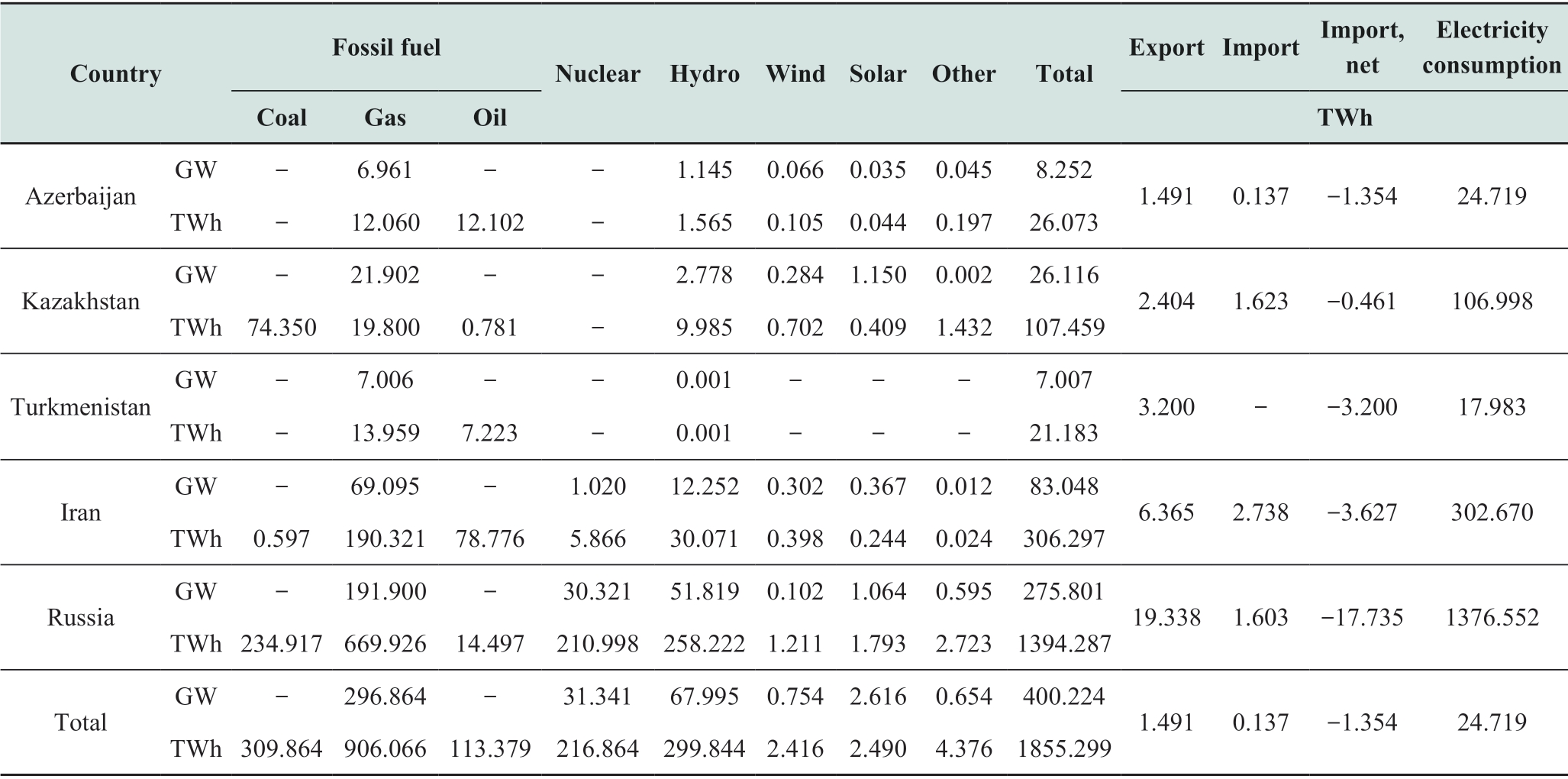
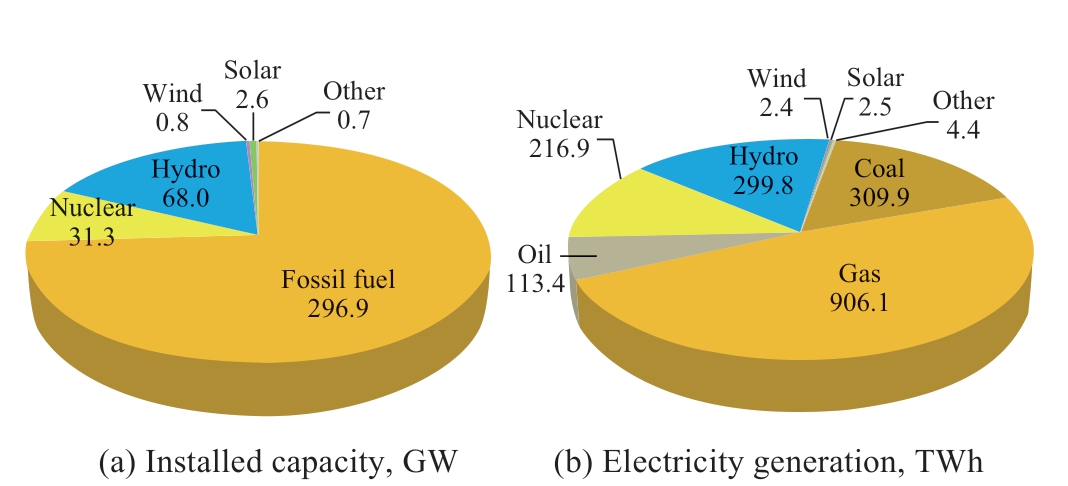
Fig.2 Capacity and power generation mix of Caspian countries,2019
The dominant role in the mix of generating capacities and electricity generation is taken by thermal power plants(TPPs),of 74.2% and 71.6%,respectively.The main fuel for generating electricity in TPPs is gas,hence the electric power sectors of these countries are environmentally friendly.
Caspian countries are self-sufficient in terms of energy resources and net exporters.The ISETs of the potential CER ISPG and the neighboring regional and national power system interconnections are depicted in Fig.3 [25].
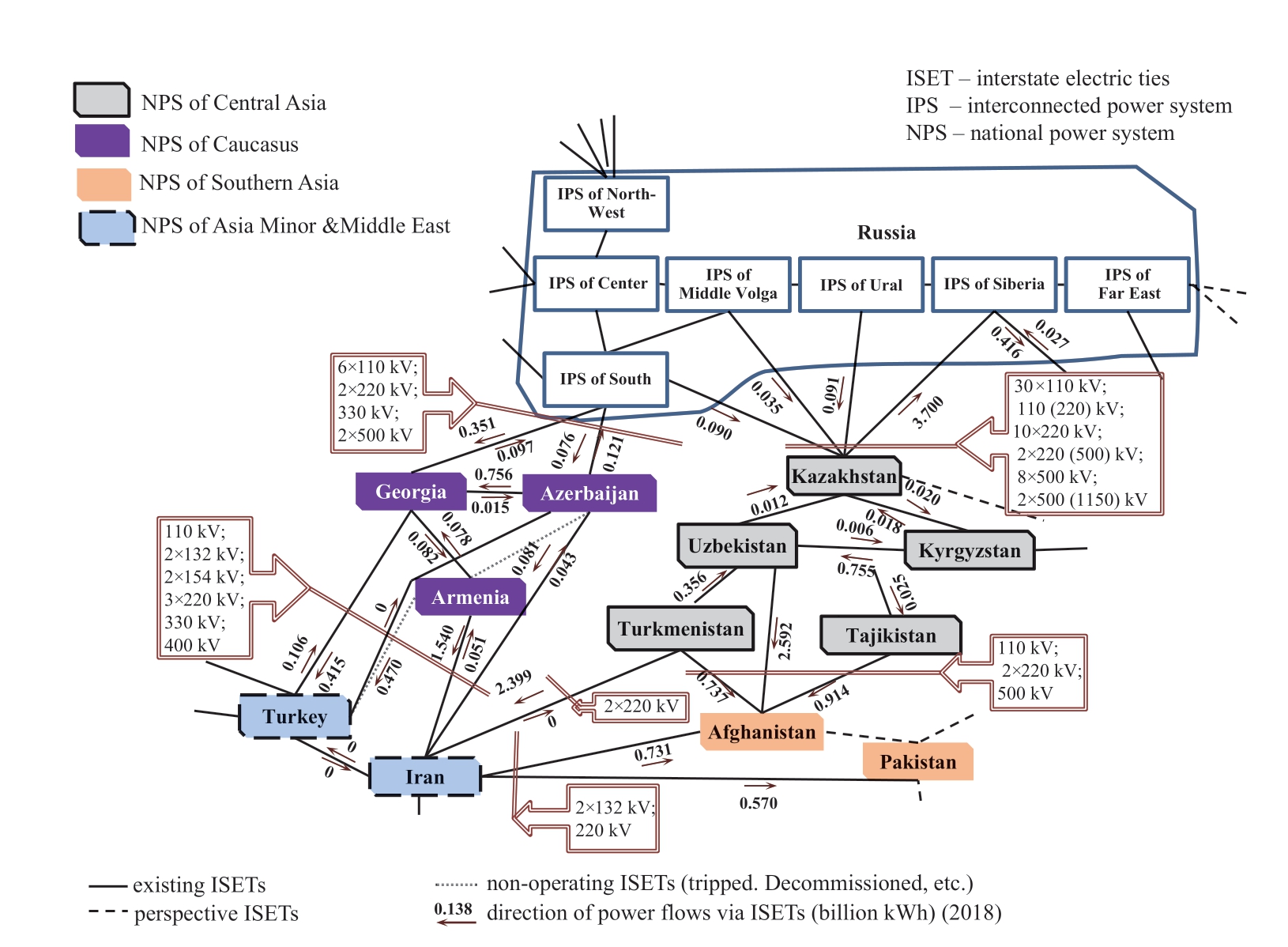
Fig.3 Interstate electric ties (ISETs) of CER,and adjacent power systems and interconnections
Today,almost all the power systems in CER countries are interconnected.The exceptions include the NPSs of Turkmenistan and Kazakhstan.Electricity from Turkmenistan to South Kazakhstan is transmitted through Uzbekistan,which is not a participant in the CER.The peculiarities of the mix of generating capacities and operating modes of power systems determine the reverse electricity exchange between countries.Russia’s UPS operates in parallel with the NPSs of Azerbaijan,Georgia,and Kazakhstan.Turkmenistan’s NPS is electrically connected to Iran’s NPS.In addition,Armenia and Iran exchange seasonal load flows.
2 Assumptions and methodology
It is assumed that the CER is based on a new power grid infrastructure constituting high-voltage direct current(HVDC) ± 800 kV transmission lines as a superstructure over the existing alternating current (AC) power grid infrastructure.HVDC transmission technology is characterized by low power loss when transmitting bulk power over long distances,and ensures the joint operation of IPSs without synchronization.The breakeven distance for HVDC overhead transmission lines (when the cost of this line is lower than the cost of the HVAC line) is in the range of 500-800 km depending on a number of other factors,such as country-specific cost elements,interest rates for project financing,loss evaluation,and cost of right of way[26].According to [27],the lower value of the range of the breakeven distance for the HVDC overhead transmission line is 300 km.
For considering sustainable development and achieving carbon neutrality,this study considered opportunities for the expansion of new environmentally friendly energy sources,in particular,nuclear power plants in Kazakhstan and renewable energy sources in Iran [28,29].
The linear programming optimization mathematical model Capacity and Network Operation and Expansion(CANOE) developed by the authors was used to conduct the study [30].The model optimizes the mix of prospective generating capacity by type of power plant and type of fuel;their seasonal,weekly,and daily (with hourly intervals)operating modes;power flows through intersystem and ISETs;and estimates the main technical and economic indicators: installed capacity,electricity generation by type of power plant,the volume of investment costs,fuel costs,and total annualized costs.
The model considers different types of power plants,including steam turbine fossil fuels (coal,gas,and oil),cogeneration fossil fuels (coal,gas,and oil),nuclear,hydro,wind,and solar.In addition,there are power storage facilities (e.g.,pumped storage hydropower plants),DC,and AC transmission lines.
The model comprises the objective function of the total cost for the expansion and operation of the entire power system or power system interconnection for the target year,installed capacity balance equations for each node of the power system,actual (hourly) power balance equations in each node of the power system,constraints on the expansion of each type of installed generating capacity,constraints on the expansion of intersystem or ISETs,and other technical and technological constraints.
The study was conducted for two scenarios of the prospective CER ISPG: 1) using the current AC transmission infrastructure of the CER,considering its predetermined planned expansion,and 2) commissioning HVDC transmission lines ± 800 kV between the countries of the Caspian region as the transmission infrastructure of the CER.The first scenario is the reference (base case) scenario.This presents a traditional (business-as-usual) expansion of the ISPG.The second scenario introduces DC transmission technology to strengthen the interstate transmission infrastructure and to create a CER interconnection.The first scenario is required to estimate the benefits of the second scenario (compared with the first scenario).
Both scenarios were optimized for the assumed target year using the CANOE model,and the main indicators of the scenarios (i.e.,installed capacity,investment,fuel cost,and total annualized cost) were determined.The difference in the above indicators in the second scenario compared with the first characterizes the potential benefits sought owing to the CER interconnection.For example,economic benefit is the difference between the optimal values of(cost) objective function of the first and second scenarios.The capacity benefit is the difference between the optimal installed capacity in the first and second scenarios,and the investment benefit is the difference between the investment in the installed capacities in the first and second scenarios.The fuel benefit is the difference between the fuel costs in the first and second scenarios.
The main optimal indicators of the second scenario obtained by the CANOE model characterize the main parameters of the CER ISPG (i.e.,transfer capability,power exchanges,investments).More specifically,these indicators characterize separate ISETs comprising the CER,and they need to be summarized to represent the entire CER.
A flowchart of the study is presented in Fig.4.
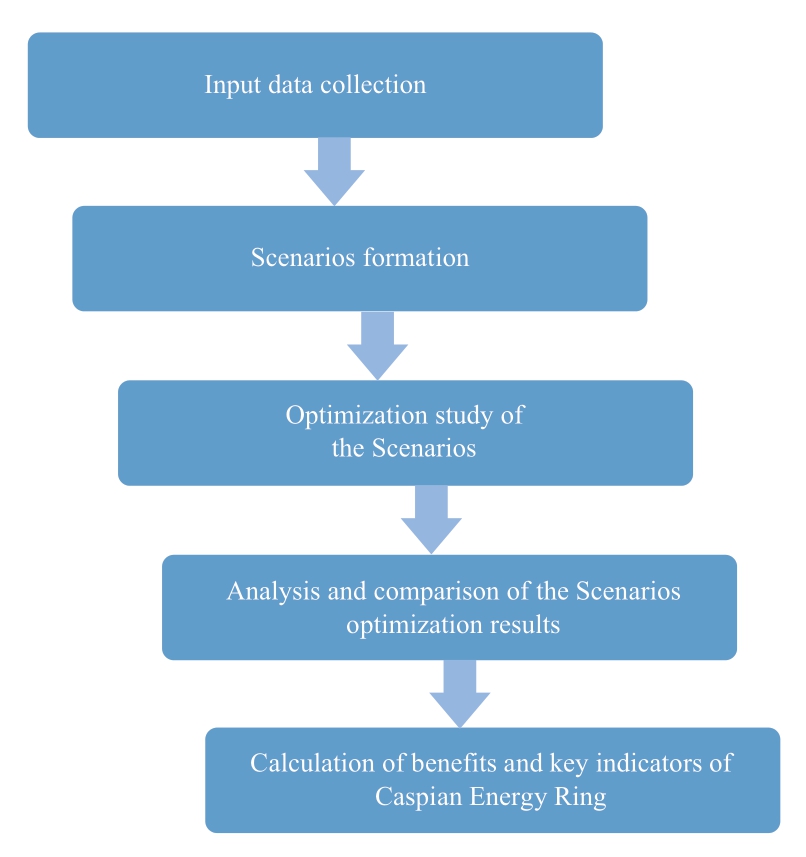
Fig.4 Methodological scheme of the study
The collection of input data for the CANOE model was the first step of this study.
3 Input data
Prospective data on electricity demand,generating capacities,and cost indicators are accepted both from the published national energy and power plans,programs,and strategies of the Caspian region countries,and datasets of international organizations such as the World Bank,International Energy Agency,and Asia Development Bank [31-40].The data in the noted documents are usually presented as scenarios considering the uncertainty of future conditions (pessimistic,medium,optimistic).The input data were taken from medium scenarios,which are considered to be the most plausible.
A diagram of the extended CER power system interconnection is represented by 16 nodes (Fig.5).The nodes of IPS of North-West Russia and IPS of Far East Russia,as shown in Fig.5,were not considered because of their remoteness.Meanwhile,the focus is on the nodes representing the power systems of the countries included in the CER (Azerbaijan,Iran,Kazakhstan,Russia,and Turkmenistan).Accounting for the remaining nodes is necessary because of the close relationship between the NPS and its operating modes.HVDC transmission lines shaping the transmission infrastructure of the CER are represented in Figs.5 and 6 by thick dark lines.
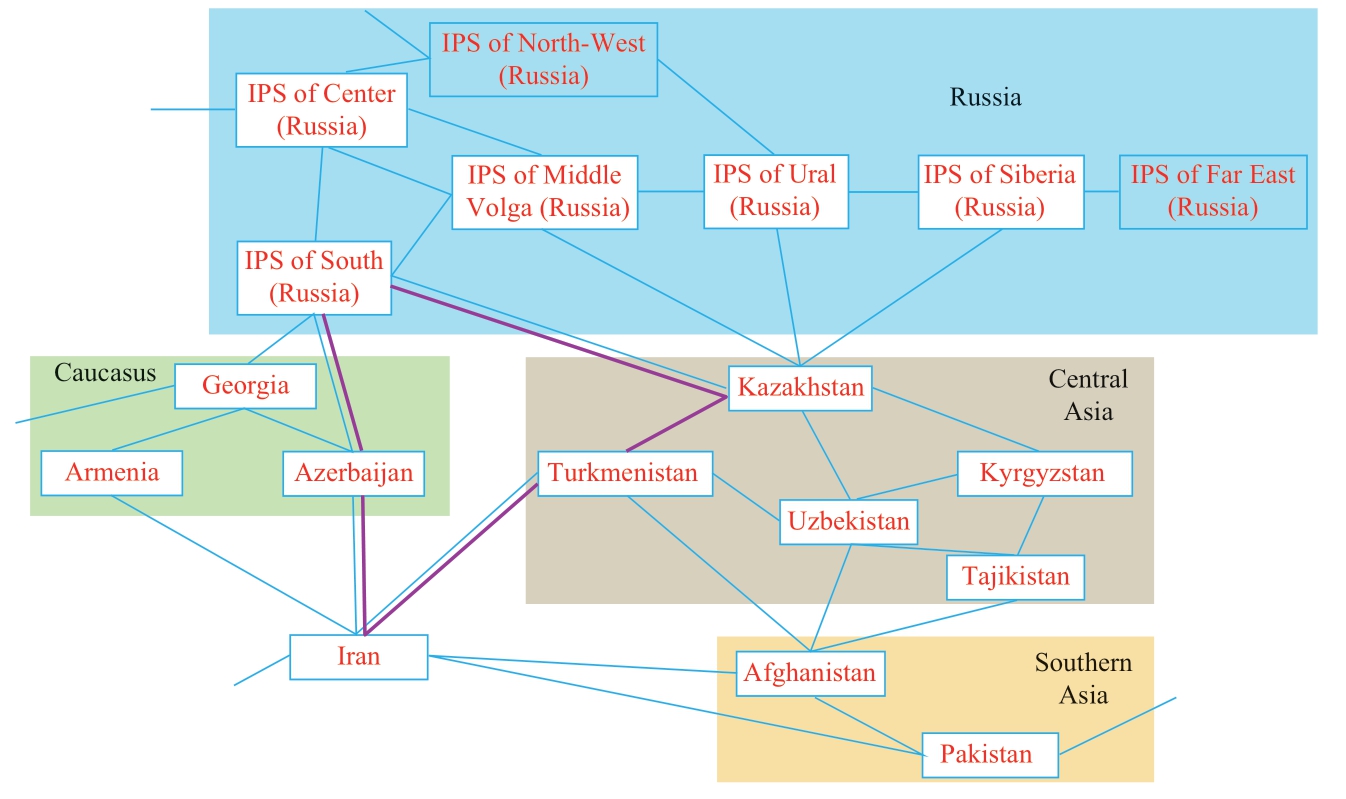
Fig.5 Diagram of the CER with power systems of adjacent countries
Table 3 details the technical and economic indicators of the HVDC ± 800 kV transmission lines comprising the ISPG CER.Indicators were calculated based on [31]and other sources.
Table 3 Technical and economic indices of ISETs

Tables 4-5 show the economic indices of the power plants [32-36].
Table 4 Capital investment in new power plants,USD/kW

continue
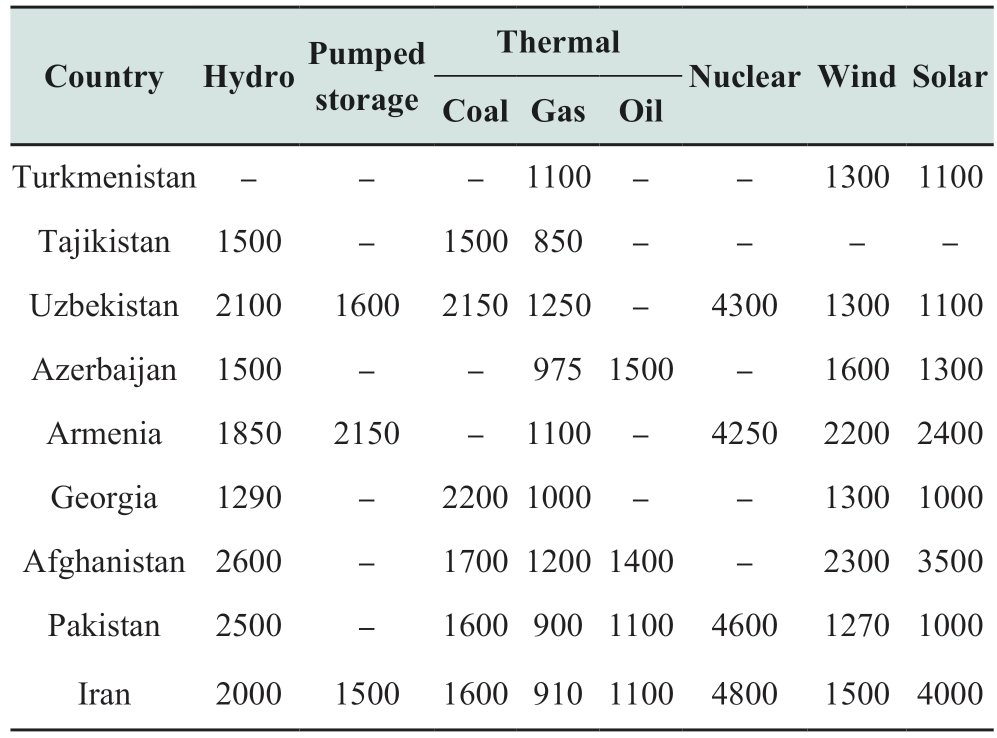
Table 5 Fuel costs,USD/MWh

The year 2040 was considered as the target year.
4 Research results and discussion
Table 6 shows the main components of the benefits of creating a CER.
Table 6 Calculated indices of scenarios
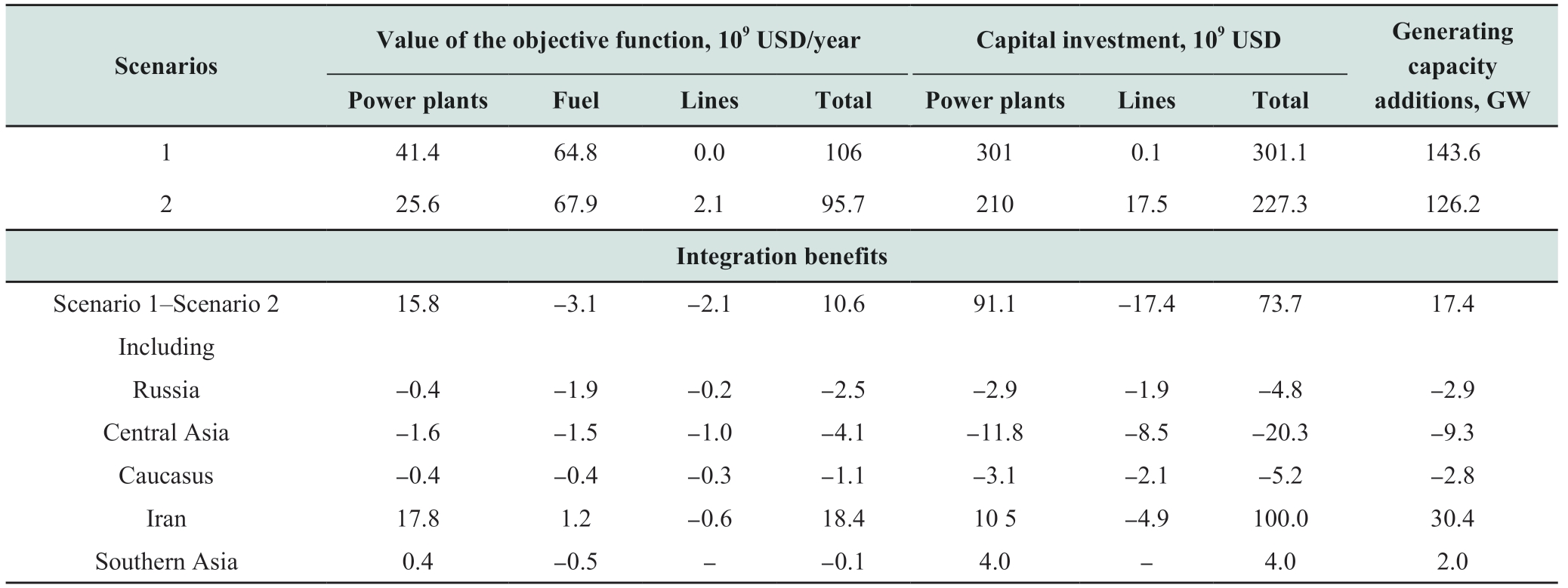
As can be seen from Table 6,the creation of the CER with involvement in the power system interconnection of NPSs of adjacent countries resulted in positive annual economic (10.6 billion USD/year),investment (73.7 billion USD),and capacity (17.4 GW) benefits.The capacity benefit is an integral part of the overall system benefit and is realized through the exchange of seasonal (when annual load curves are combined) or intraday (when daily load curves are combined) power flows between NPSs.
Increases in capital costs for electric ties in scenario 2 compared with scenario 1 in the amount of 17.4 billion USD (see Table 6) reflect the costs to the power grid infrastructure of the CER.
Figure 6 illustrates the annual power flows between countries/nodes,including along the transmission lines shaping the CER,obtained from the model calculations.
From Fig.6,there is a significant growth of more than 300 TWh/year in electricity exchanges between the countries of the CER (scenario 2).
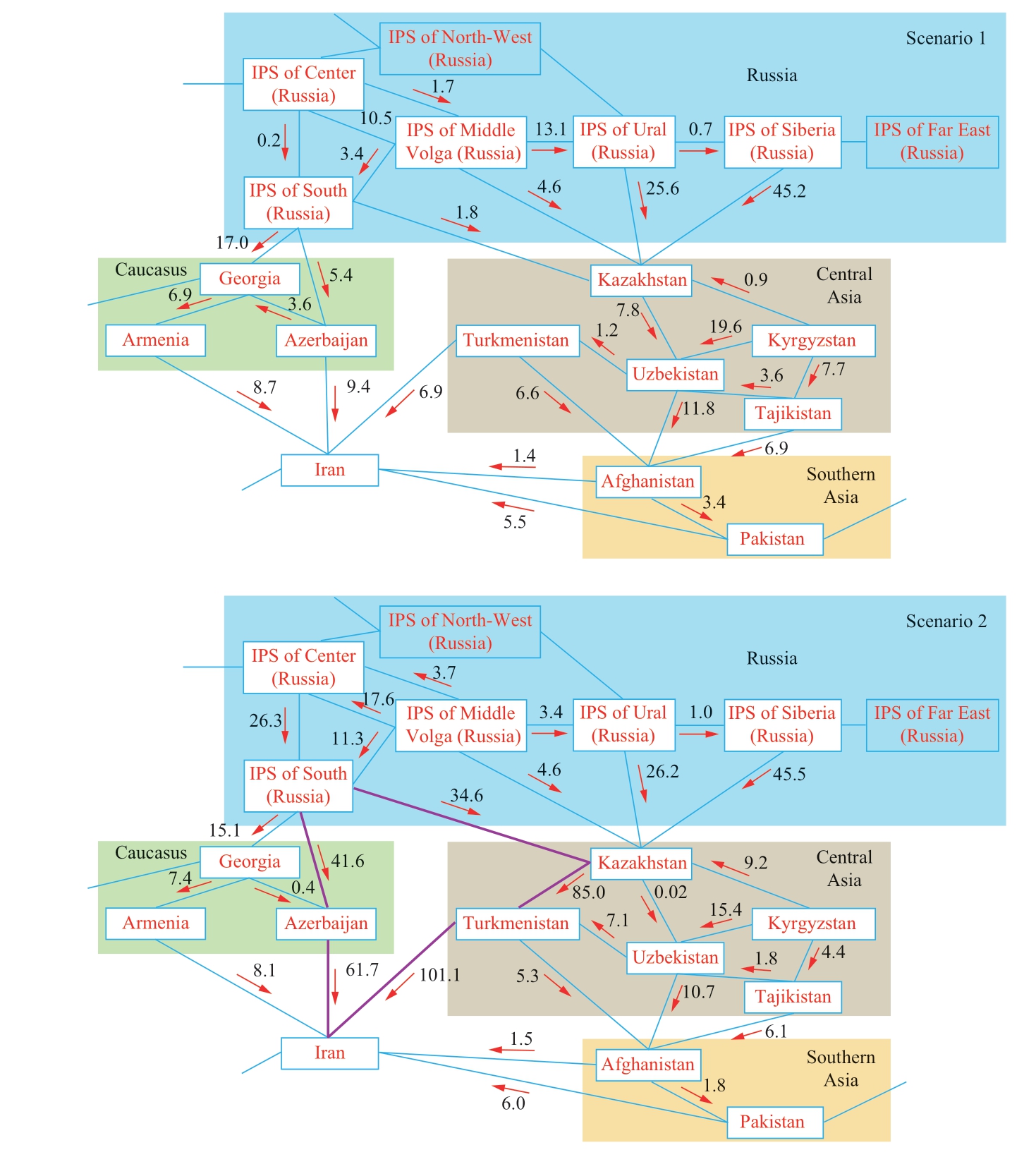
Fig.6 Calculated power flows by scenario,TWh/year
The impact of the CER goes beyond its member countries.Outside the CER,changes are also taking place,in particular:
-in the UPS of Russia,the annual internal volume of the power flow increases by 33.6 TWh in the direction of the IPS of the South of Russia,which is an integral part of the CER;
-in the ISPG of Central Asia,the increase in power flows is 79.6 TWh/year,which is explained not only by the emergence of a new ISET between Turkmenistan and Kazakhstan,but also by the growth of electricity transit through the CER from Russia.
The results in Tables 7 and 8 show that the creation of the Energy Ring leads to the close integration of national energy systems,not only within the framework of a potential CER project,but also with a broader territorial consideration,considering other countries of Central and South Asia and the Caucasus.This is demonstrated,in particular,by changes in the mix of installed capacities and the generation of electricity,which are provided in these tables.
Furthermore,from Tables 7 and 8,low-carbon gas-fired TPPs play a significant role in power interconnection,which is due to the presence of substantial reserves of natural gas in the countries of the region.Their shares in the total installed capacity and electricity generation in scenario 2(creation of CER) are 45% and 52%,respectively.Including hydraulic,nuclear power plants,and renewable energy,the total share of carbon-free and low-carbon sources in the installed capacity and electricity generation is approximately 80% (scenario 2).Thus,the electric power grids of the countries of the Caspian Sea and the adjacent countries of the Caucasus and Central and South Asia are highly environmentally friendly.
Table 7 Installed capacity,GW
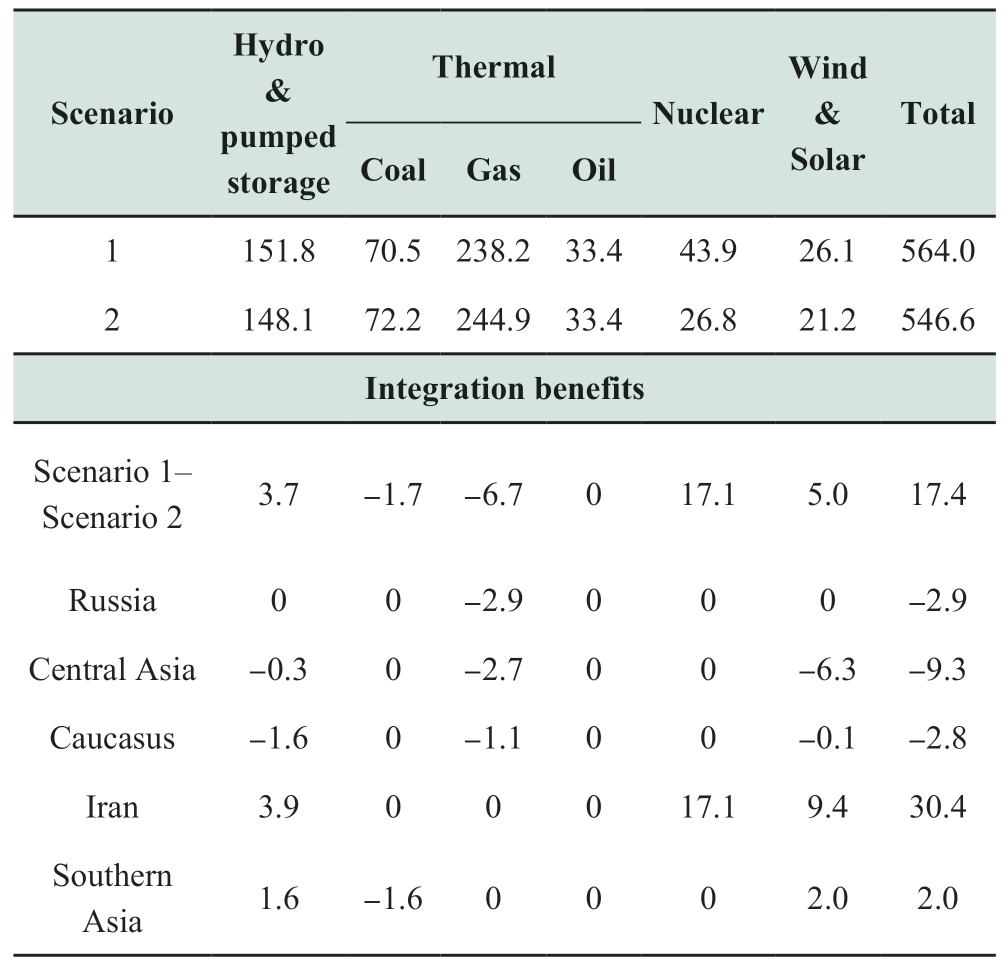
Table 8 Electricity generation,TWh
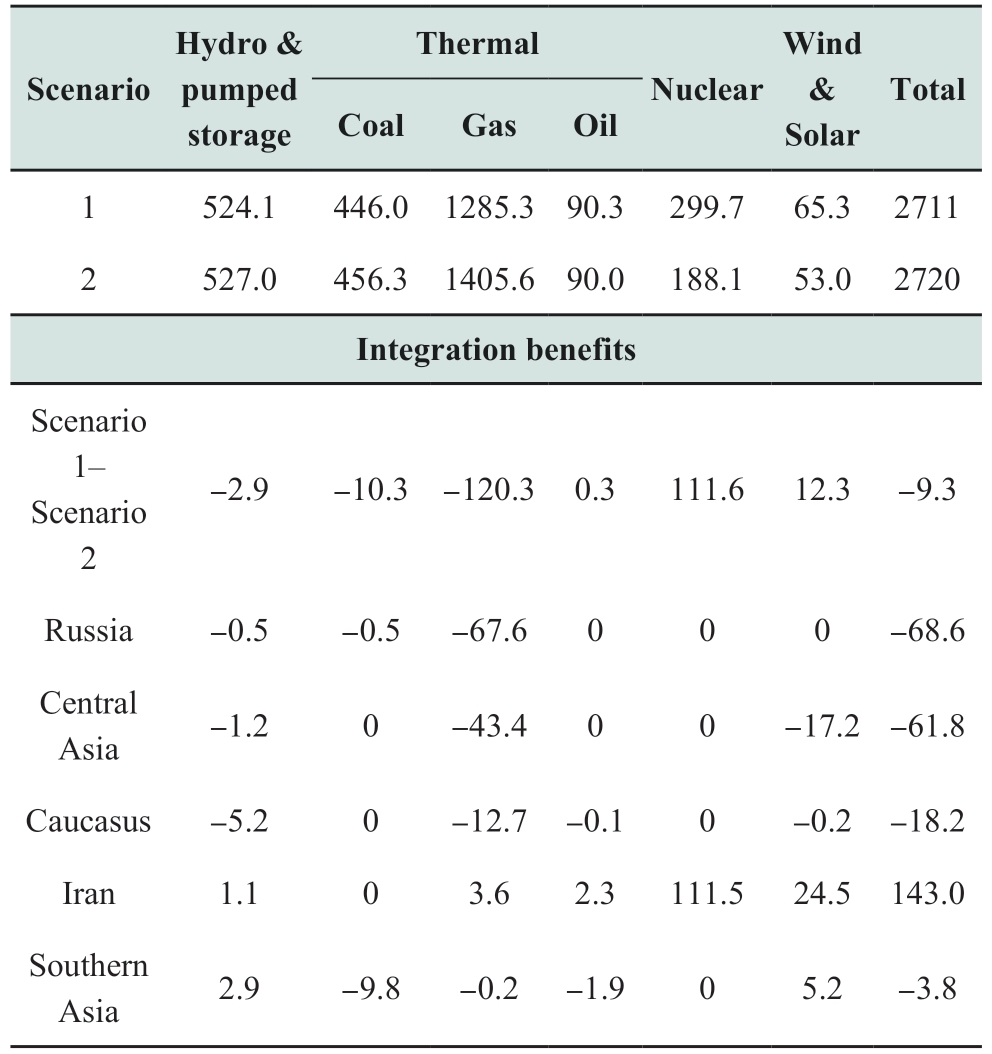
The main component of the capacity benefit in Table 7 is the reduction in the addition of expensive carbon-free nuclear power plants.The capacity addition of renewables is also reduced to some extent.Meanwhile,the addition of capacities and power generation of low-carbon gas-fired power plants is increasing,as well as the slight increase in the addition of capacities and generation of high-carbon coal-fired TPPs.Thus,the implementation of the CER project does not significantly contribute to the carbon-free expansion of the Caspian Sea region and adjacent territories.The stimulation of the expansion of carbon-free and lowcarbon energy sources requires special mechanisms.As such a mechanism,we considered a tax on CO2 emissions of USD 60/ton [41,42].
A study of an additional scenario that accounts for a tax on CO2 emissions showed that the total installed capacities of wind and solar power plants under the conditions of the creation of the CER exceeded 43 GW.Thus,the renewable capacity additions are doubled compared with scenario 2 with no tax.In Kazakhstan,a new source of electricity entered the optimal balance: a nuclear power plant with the installed capacity of 2.4 GW.Simultaneously,the total volume of electricity transmitted through the ISETs of the CER increased by 70 TWh/year.
As a result of introducing a tax on CO2 emissions and creating the CER,the share of all non-carbon and low-carbon power sources in the total installed capacity amounted to 82% and 86%,respectively.
The overall increase in electricity generation exhibited in Table 8 is associated with an increase in power flows through the ISETs and,accordingly,an increase in additional electricity losses.
Table 9 shows the calculated changes in the ISETs transfer capability in the case of the creation of the ISPG CER(scenario 2).The total increase was 47.1 GW.Thus,the total transfer capability of the CER was approximately 47 GW.
Table 9 Calculated transfer capabilities of CER ISETs,GW

5 Conclusion
Studies have shown that CER creation with involvement in the power system interconnection of NPSs of adjacent countries appears to be economically viable.It provides the potential positive annual economic benefit of 10.6 billion USD,investment benefit of 73.7 billion USD,and capacity benefit of 17.4 GW.
Creating the power grid infrastructure of the CER(in the form of HVDC ± 800 kV transmission lines) will require over USD 17 billion.The total capacity of these transmission lines will exceed 47 GW,and the total volume of power flowing through them will be approximately 300 TWh/year.
The Caspian Sea region has significant reserves of fuel and energy resources,including low-carbon natural gas.In this regard,natural gas plays an important role in the electricity balances of these countries,particularly in the event of the formation of the CER (45% capacity and 52% power generation).Including hydraulic,nuclear,and renewable energy sources,the total share of low-carbon and carbon-free sources is approximately 80% of the installed capacity and generation of power plants in the CER and neighboring countries.
In the case of the introduction of a tax on CO2 emissions of USD 60/ton,this share will increase to 82% in installed capacity and 86% in generated electricity.
The creation of the CER is of regional importance,as it interconnects the power systems of the Caspian Sea countries and adjacent territories.In the long term,it contributes to creating the Eurasian Supergrid and,along with the mechanism for carbon emission reduction,will facilitate the achievement of carbon neutrality.
Further studies will focus on calculating the benefits of CER interconnection for each participating country,detailed consideration of renewable national policies of the countries of CER,and thoroughly accounting for technical issues of power interconnection.The findings in this study contribute to the creation of a scientific basis for the formation of the CER.
Acknowledgements
The research was carried out under the State Assignment Project (FWEU-2021-0001) of the Fundamental Research Program of the Russian Federation 2021-2030 using the resources of the High-Temperature Circuit Multi-Access Research Center (Ministry of Science and Higher Education of the Russian Federation,project No.13.CKP.21.0038).
Declaration of Competing Interest
We declare that we have no conflict of interest.
References
[1]Seferov A K,Illeritskiy N I (2016) Energy cooperation of the Caspian States: problems and prospects.IMEMO,Moscow.https://www.imemo.ru/files/File/ru/conf/2016/29042016/01_04_Illeritskiy_Seferov.pdf.Accessed March 10,2022
[2]Budargin O M (2017) Electric power driver of supergrids,Electric Power Transmission and Distribution.3(42): 4-7
[3]Voropai N,Podkovalnikov S,Chudinova L (2021) The evolution of interstate power grid formation,Global Energy Interconnection,4(4): 335-353
[4]Belyaev L S,Podkovalnikov S V,Chudinova L (2021) Electric power Reintegration of Russia with the countries of the Central Asian and Caspian regions.Eurasian Integration: Economics,Law,and Politics,14(1): 32-43
[5]Westphal K,Pastukhova M,Pepe J M (2022) Geopolitics of electricity: Grids,space and (political) power.Stiftung Wissenschaft und Politik,06
[6]He S,Foley A,Chen N,et al.(2021) Cooperative electric energy transmission between Central Asia and Pakistan,Energy Strategy Reviews,38: 100756
[7]Shamsiev K A (2018) The interconnected power grid of Central Asia: regional trade outlooks.ENERGIA Coordination and Dispatch.https://www.carecprogram.org/uploads/05-The-Interconnected-Power-Grid-of-Central-Asia-Regional-Trade-Outlooks.pdf.Accessed 24 June 2022
[8]Bogdanov D,Breyer C (2015) Eurasian super grid for 100%renewable energy supply: Generation and storage technologies in the cost optimal mix.Proceedings of Neo-Carbon Energy 4th Researchers’ Seminar,October 19-20,2015,41-48
[9]Belyaev L S,Voropai N I,Koshcheev L A (2000) Prospects for the exdpansion of interstate energy interconnections on the Eurasian supercontinent,Izvestiya RAN.Energetika,2: 27-35
[10]Liu Z (2015) Global energy interconnection.Elsevier Academic Press
[11]Zverev Y M (2013) Electric energy cooperation in the Baltic Sea region and the role of Russia in it.Baltic region,2(16): 66-77
[12]Editorial M (2010) Mediterranean Ring: Single grid plan stalls.https://www.meed.com/mediterranean-Ring-single-grid-planstalls/.Accessed 24 May 2022
[13]United States Energy Association (2018) Analysis of the potential to provide cross border balancing services and energy in the Black Sea region.https://usea.org/sites/default/files/Joint%20 BSTP%20and%20BSRI%20Study%20FINAL%20EN.pdf.Accessed 24 May 2022
[14]Armenian National Committee of America (2016) Energy corridor agreement signed by Armenia,Russia,Iran and Georgia.https://anca.org/north-south-energy-corridor-agreement-signedby-armenia-russia-iran-and-georgia.Accessed 02 May 2022
[15]Caspian News (2019) Azerbaijan,Iran &Russia agree to connect energy grids.https://caspiannews.com/news-detail/azerbaijaniran-russia-agree-to-connect-energy-grids-2019-8-16-16/.Accessed 02 May 2022
[16]Government of the Islamic Republic of Iran (2021) Iran,Turkmenistan discuss bilateral cooperation in electricity field.https://irangov.ir/detail/376576.Accessed 02 May 2022
[17]United Nations Framework Convention on Climate change Paris Agreement,2015
[18]Nuclear Energy Agency organization for economic Cooperation and Development (2020) Uranium 2020: Resources,production and demand.Boulogne-Billancourt,France.https://oecd-nea.org/upload/docs/application/pdf/2020-12/7555_uranium_-_resources_production_and_demand_2020__web.pdf.Accessed 02 May 2022
[19]National Renewable Energy Laboratory (2013) Global CFDDAbased onshore and offshore wind potential supply curves by country,class,and depth (quantities in GW and PWh).http://en.openei.org/doe-opendata/dataset/c186913f-6684-4455-a2f2-f26e152a9b35/resource/4dc4a6fd-3a63-47df-bcbee9c83b83b38e/download/nrelcfddawindsc20130603.xlsx.Accessed 30 March,2020
[20]National Renewable Energy Laboratory (2019) Resource class &country.https://openei.org/doe-opendata/dataset/19316a50-e55d-45e2-b692-efcebfe16c95/resource/544e4dcc-95bc-480a-9669-64e444356c46/download/solarresourceenergytiltlatsubtotaled.xlsx.Accessed 24 May 2019
[21]British Petroleum (2022) Statistical review of world energy July 2021.https://www.bp.com/content/dam/bp/business-sites/en/global/corporate/xlsx/energy-economics/statistical-review/bpstats-review-2021-all-data.xlsx.Accessed 24 May 2019
[22]World Energy Council (2013) World energy resources.2013 Survey,London,United Kingdom.https://www.worldenergy.org/assets/images/imported/2013/09/Complete_WER_2013_Survey.pdf
[23]World Energy Council (2010) 2010 Survey of energy resources,London,United Kingdom.https://www.worldenergy.org/assets/downloads/ser_2010_report_1.pdf.Accessed 15 March 2022
[24]United Nations Statistics Division (2020) 2018 The electricity profiles,New York,USA.https://unstats.un.org/unsd/energystats/pubs/eprofiles/.Accessed 19 Feb 2021
[25]Belyaev L,Podkovalnikov S,Chudinova L (2020) Russia’s electrical power reintegration with Central Asia,Caucasus,and entering South Asia and Middle East electricity markets https://www.e3s-conferences.org/articles/e3sconf/pdf/2020/69/e3sconf_energy-212020_04001.pdf.Accessed 02 May 2022
[26]Siemens (2011) High voltage direct current transmissionproven technology for power exchange.https://www.brown.edu/Departments/Engineering/Courses/ENGN1931F/HVDC_Proven_TechnologySiemens.pdf.Accessed 24 June 2022
[27]Ludin G A,Nakadomari A,Yona A,et al.(2022) Technical and economic analysis of an HVDC transmission system for renewable energy connection in Afghanistan.Sustainability,14(3): 1468
[28]World Nuclear News (2021) Nuclear optimal solution for decarbonizing Kazakhstan,says president.https://www.worldnuclear-news.org/Articles/Nuclear-optimal-solution-fordecarbonising-Kazakhs.Accessed 02 May 2022
[29]Ghorbani N,Aghahosseini A (2019) Assessment of a costoptimal power system fully based on renewable energy for Iran by 2050-Achieving zero greenhouse gas emissions and overcoming the water crisis.Renewable Energy,146: 125-148
[30]Podkovalnikov S,Chudinova L,Trofimov I L,et al.(2022)Structural and operating features of the creation of an interstate electric power interconnection in North-East Asia with largescale penetration of renewables,Energies,15(10): 3647
[31]Raza A,Shakeel A,Hassan H,et al.(2017) Economic analysis for HVDC transmission system in Pakistan.International Journal of control and Automation,10(11): 29-38
[32]Fichtner (2013) Update of the power Sector Master plan of Azerbaijan 2013-2025,Suttgars,Germany.http://www.inogate.org/documents/3_FICHT-11527706-v2-Final_Report_Azerbaijan.pdf.Accessed 02 May 2022
[33]Ataei A,Fararian K (2015) Environmental and economic analysis of scenarios for transition to renewable energy in the Iranian electricity supply system.International Journal of Energy Science and Engineering,1(4): 153-162
[34]World Bank (2015) How much could South Asia benefit from regional electricity cooperation and trade? http://documents.worldbank.org/curated/en/846141468001468272/pdf/WPS7341.pdf.Accessed 02 May 2022
[35]International Energy Agency (2020) Projected cost of generating electricity.2020 edition.International Energy Agency,Nuclear Energy Agency,Organization for economic Cooperation and Development,Paris.https://iea.blob.core.windows.net/assets/2df33f6b-eba0-4639-926a-bc1c3d3e3268/IEA-NEAProjec tedCostsofGeneratingElectricity2020-Datafile.xlsx.Accessed 02 May 2022
[36]Asia Development Bank (2015) Economics of climate change in Azerbaijan,Kazakhstan,and Uzbekistan: Final summary report and investment concept notes.http://adb.org/projects/documents/ta8119-aze-kaz-uzb-report-and-concept-notes-tacr.Accessed 24 May 2022
[37]Decree of the Government of the Republic of Kazakhstan (2014)Concept for the development of the fuel and energy complex of the Republic of Kazakhstan until 2030.http://www.cawater-info.net/library/rus/kaz-724-2014.pdf.Accessed 20 August 2022
[38]The concept of the sustainable energy strategy for the future of Kazakhstan until 2050.https://kaznaen.kz/wp-content/uploads/2018/10/1-%D0%BD%D0% BE%D0%BC%D0%B5%D1%80-2017-%D0% BF% D0%BE%D1%87%D1%82%D0%B0.pdf.Accessed 20 August 2022
[39]Moshiri S,Lechtenböhmer S (2015) Sustainable energy strategy for Iran,Wuppertal Spezial,(51) Wuppertal Institut für Klima,Umwelt,Energie,Wuppertal.https://www.econstor.eu/bitstre am/10419/142741/1/861697359.pdf.Accessed 20 August 2022
[40]Energy strategy of the Russian Federation until 2035 (2019).https://www.infobio.ru/sites/default/files/Energostrategiya-2030.pdf.Accessed 20 August 2022
[41]Luckow P,Stanton E A,Fields S,et al.(2016) Spring 2016 national carbon dioxide price forecast.Synapse Economics,Cambridge Massachusetts.https://www.synapse-energy.com/sites/default/files/2016-Synapse-CO2-Price-Forecast-66-008.pdf.Accessed 24 May 2022
[42]World Bank (2019) State and trends of carbon pricing 2019.Washington,2019.https://openknowledge.worldbank.org/handle/10986/31755.Accessed 24 May 2022
Received: 30 May 2022/Accepted: 29 August 2022/Published: 25 October 2022
 Sergei Podkovalnikov
Sergei Podkovalnikov
spodkovalnikov@isem.irk.ru
Lyudmila Chudinova
chudinova@isem.irk.ru
Ivan L.Trofimov
t_john88@isem.irk.ru
Leonid Trofimov trofi@isem.irk.ru
2096-5117/© 2022 Global Energy Interconnection Development and Cooperation Organization.Production and hosting by Elsevier B.V.on behalf of KeAi Communications Co.,Ltd.This is an open access article under the CC BY-NC-ND license (http://creativecommons.org/licenses/by-nc-nd/4.0/).
Biographies

Sergei Podkovalnikov,Doctor of Engineering,Deputy Director of Melentiev Energy Systems Institute of Siberian Branch of the Russian Academy of Sciences (ESI SB RAS).He was with Pace University (USA) as a Fulbright scholar.He participated in the North-East Asia Regional Electric System Tie project,working with the Korea Electrotechnology Research Institute (Republic of Korea).He is an IEEE Member.His research interests include methods for decision-making in energy under uncertainty and multiple criteria,interstate electric ties and interconnected power systems,expansion planning of the electric power industry in the market environment,and modeling of electric power systems.He has been the author and co-author of more than 220 research papers and books.

Lyudmila Chudinova is a senior researcher of the ESI SB RAS.She has a Ph.D.in engineering.Her scientific interests include interstate electric ties,modeling of power systems,and hydropower.She has published 70 scientific papers.

Ivan L.Trofimov, Irkutsk,Russia,is Junior Researcher at ESI SB RAS.His research interests include web &information technologies and their implementation in the energy field.

Leonid Trofimov,Irkutsk,Russia,is Leading programmer at ESI SB RAS.His professional interests include software developing,data visualization,geo-information systems,object data structure,and data processing.
(Editor Yajun Zou)
